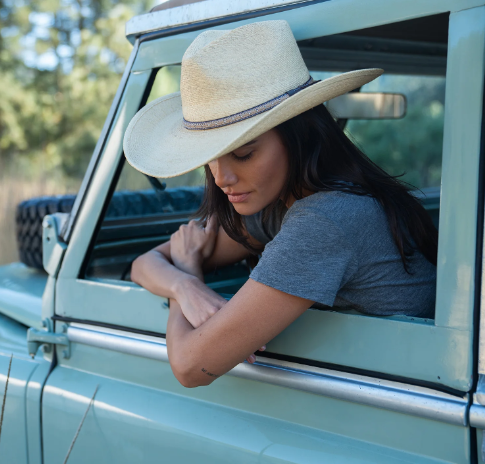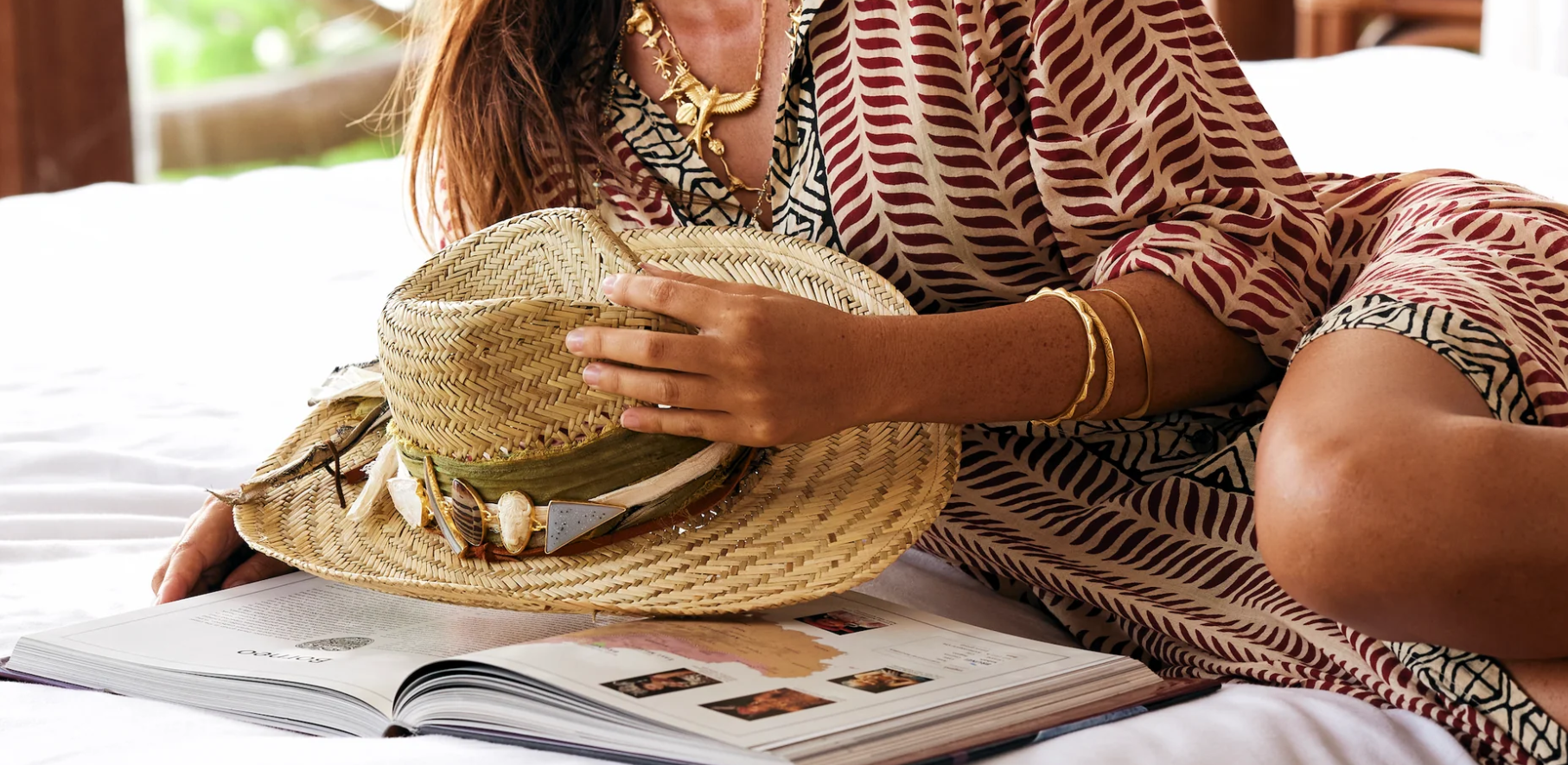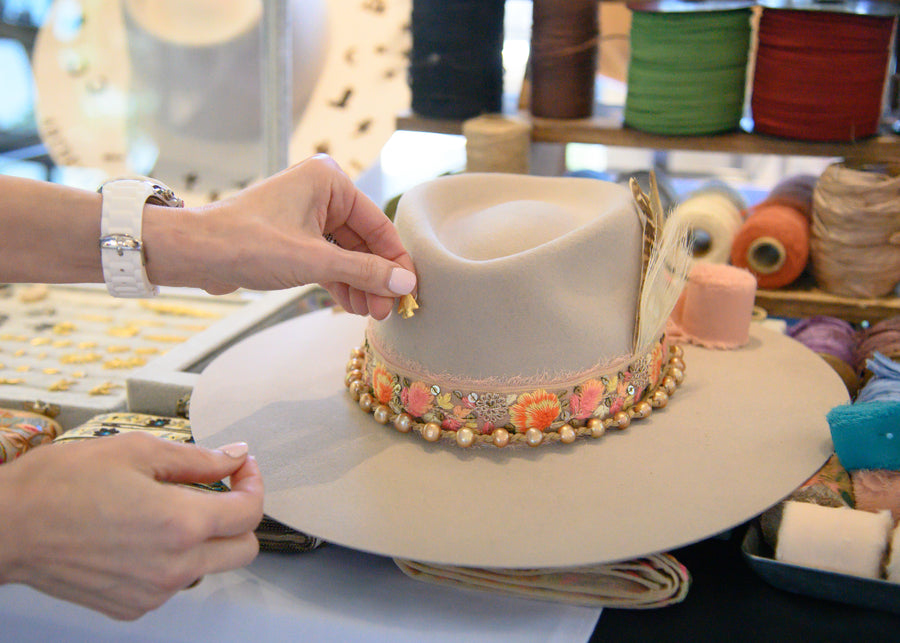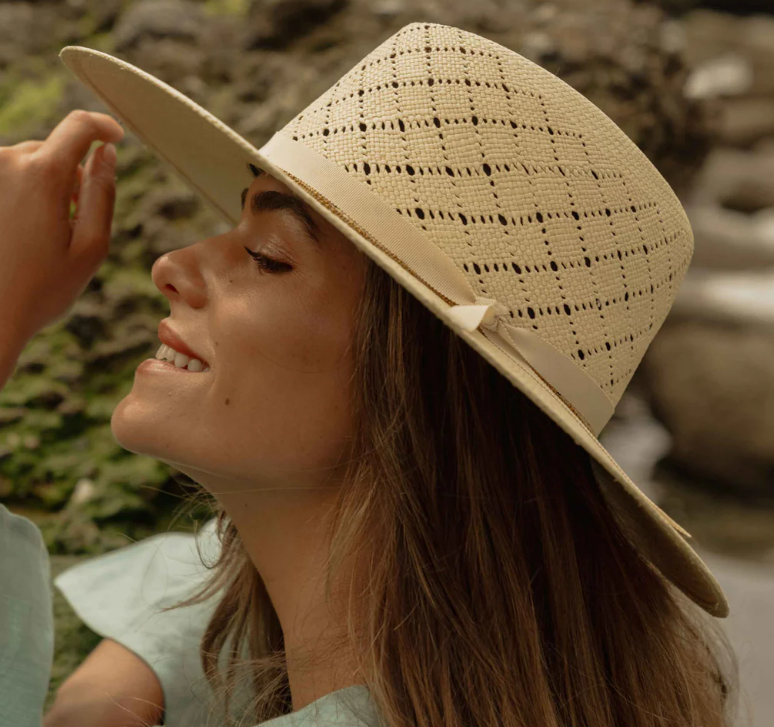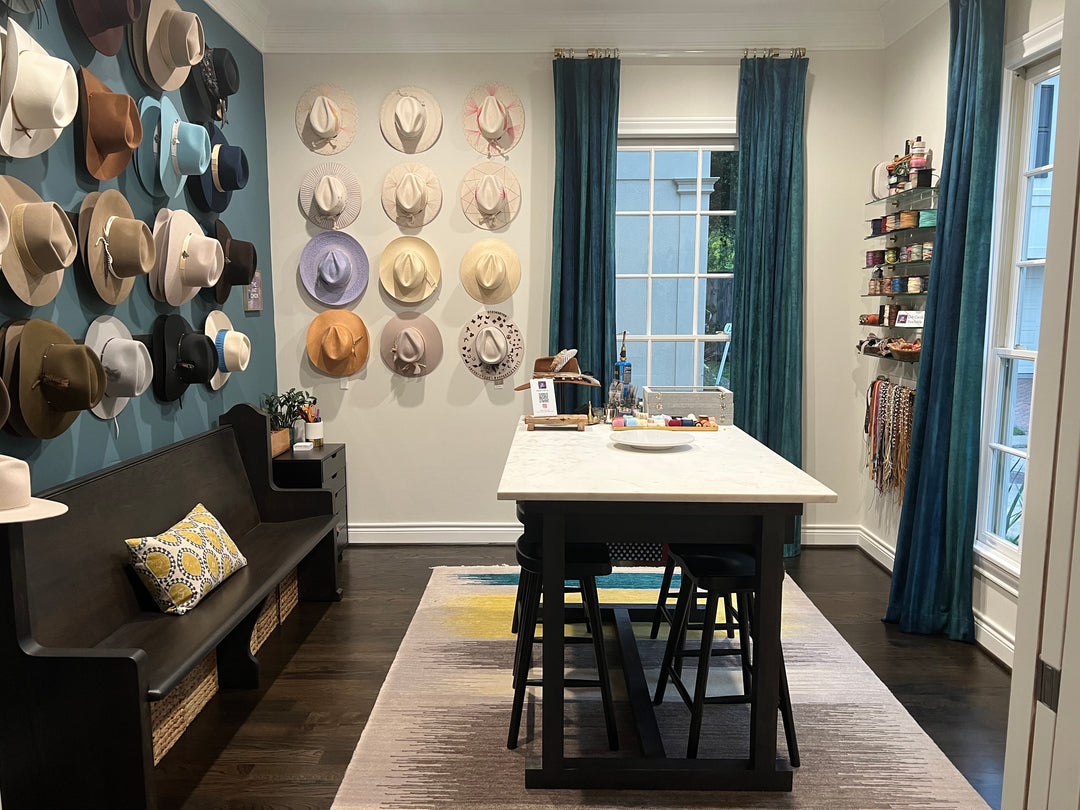The Ultimate Hat Sizing Guide: Finding Your Perfect Fit

Hello, beautiful hat enthusiasts! Leslie here from The Hat Chick, and today we're tackling one of the most crucial aspects of hat wearing that can absolutely transform your style: getting the perfect hat size.
You know that feeling when you spot an amazing hat that speaks to your soul, but then it just doesn't look right once it's on your head? Nine times out of ten, it's a sizing issue, not the hat itself. I've watched countless customers experience this disappointment – and I've definitely had my own share of sizing mishaps over the years! But here's the thing: finding your perfect fit doesn't have to be a guessing game.
Whether you're shopping online for straw hats, browsing western hats, or treating yourself to that custom felt hat you've been eyeing, this guide will ensure you never have another "it looked better in the store" moment again.
Why Hat Sizing Actually Matters (More Than You Think!)
Before we get into the nitty-gritty of measuring, let's chat about why nailing your hat size is such a game-changer. Sure, comfort is a major factor (nobody wants a headache from their headwear!), but there's so much more to it. The right fit is what transforms you from someone wearing a hat to someone who truly owns their look with unshakeable confidence.
For Your Comfort
A well-fitted hat should feel secure without being tight. Your hat should never cause throbbing temples or leave you with those embarrassing forehead dents that scream "I wore a too-tight hat all day!" Trust me, I've walked around with that unflattering ring around my head more times than I care to admit before I learned proper hat fitting!
For Your Style
Here's what many people don't realize: the wrong size can completely change how a hat looks on you. A too-small hat will sit high on your head like a tiny crown (not the good kind), while an oversized hat can swallow your features and make you look like you're playing dress-up in someone else's closet. Hats can also fit differently with different hairstyles - try adding a slightly larger size to your collection for those days where you wear your hair a bit more full.
For Longevity
A properly fitted hat will maintain its shape better over time. When a hat is too tight, you're constantly stretching the materials. Too loose? It's more likely to fall and get damaged, or you'll be constantly adjusting it (hello, hair disasters).
Your Step-by-Step Hat Measuring Guide
Ready to become a hat sizing pro? The whole process is much more manageable than it sounds, and we'll be working with basic household items that are probably collecting dust somewhere in your home right now.
What You'll Need:
-
A flexible measuring tape (the kind used for sewing)
-
A mirror
-
A friend (optional, but helpful!)
-
A pen and paper to jot down your measurements
Don't have flexible measuring tape? No worries! You can use a piece of string and then measure it against a ruler.

Step 1: Find Your Hat Line
This is most important, so take your time to get this right! Your "hat line" isn't your hairline – it's about an inch above your eyebrows and just above the tops of your ears. This is where most hats naturally sit, whether you're wearing women's hats, men's hats, or unisex styles.
Simply run your fingers around your head to find this spot. It should feel like a natural resting place, about where a headband would sit comfortably.
Step 2: Position the Measuring Tape
Wrap your measuring tape around your head along that hat line you just found. The tape should be snug but not tight – think "firm hug" rather than "death grip."
Make sure the tape is level all the way around. This is where having a friend or using a mirror really helps! The tape can sometimes shift without you realizing it.
Step 3: Take Your Measurement
Where the tape overlaps, that's your head circumference. Write it down immediately – trust me, you'll forget!
Most people measure between 21-24 inches (53-61 cm), but everyone's different. I've measured heads as small as 20 inches and as large as 26 inches, so don't worry if you're outside the "average" range.
Step 4: Double-Check Your Work
Take the measurement two more times to make sure you're consistent. If you're getting different numbers, you might be positioning the tape slightly differently each time. Take your time with this – accuracy here saves disappointment later!
Pro Tips for Accurate Measuring:
-
Measure when your hair is styled the way you'll typically wear it with hats
-
If you have very thick or curly hair, you might need to account for that in your sizing
-
Take measurements at different times of day – believe it or not, your head can swell slightly throughout the day!
-
Consider the hat material: felt hats and structured styles need a more precise fit than soft straw hats or flexible palm hats
Understanding Hat Sizes: The Sizing Chart Decoded
Now that you have your measurement, let's translate that into hat sizes. Unfortunately, hat sizing isn't standardized across all brands (I know, I know – it's frustrating!), but here's the general breakdown:
Standard US Hat Sizes:
-
Small: 21¼ - 21⅝ inches (54-55 cm)
-
Medium: 22 - 22⅜ inches (56-57 cm)
-
Large: 22¾ - 23⅛ inches (58-59 cm)
-
X-Large: 23½ - 23⅞ inches (60-61 cm)
-
XX-Large: 24¼ - 24⅝ inches (62-63 cm)
Numerical Sizes
Size 7 = 22 inches, Size 7⅛ = 22⅜ inches, Size 7¼ = 22¾ inches, and so on.
European Sizing
Usually matches your measurement in centimeters (so 57 cm = size 57).
Common Hat Sizing Problems (And How to Fix Them!)
Let me share some real talk about the most common sizing issues I see, plus my tried-and-true solutions:
Problem #1: "My hat keeps falling over my eyes!"
The Issue: Your hat is too big for your head circumference or your head shape.
Quick Fixes:
-
Hat sizing tape or foam strips: These are lifesavers! Stick them inside the sweatband to take up extra space. I always keep these in my hat care kit.
-
Tissue paper trick (for those on-the-go moments): In a pinch, carefully placed tissue paper can help fill gaps.
-
Professional adjustment: We can add sizing tape or even take in the band slightly.
Problem #2: "My hat gives me a headache after 30 minutes"
The Issue: Your hat is too tight, or the band is hitting the wrong spot on your head.
Solutions:
-
Hat stretcher: These wooden contraptions are magical for gently expanding felt hats, western hats, and other structured styles by half a size or so.
-
Steam method: Be careful with this one! Some hats can be gently steamed and stretched, but check the material first. This works well for felt hats but can damage straw hats or palm hats. Its best to leave this to us professionals.
-
Wear it gradually: Sometimes you can gradually break in a slightly tight hat by wearing it for short periods.
-
Consider custom hats: If you consistently have sizing issues, investing in custom hats might be worth it for your most-worn styles.
Problem #3: "The hat looks great in photos but weird in real life"
The Issue: You might have the right circumference but the wrong depth or crown height for your face shape.
What to Consider:
-
Face shape matters: Round faces often look great in hats with higher crowns, while longer faces might prefer wider brims with lower crowns.
-
Proportion is key: A petite person might be overwhelmed by a hat that looks perfect on someone taller.
Problem #4: "One size fits all"
The Reality Check: "One size fits all" usually means "one size fits some people okay." If you love a one-size-fits-all style, look for versions with adjustable features like drawstrings, elastic bands, or adjustable straps.
Special Considerations for Different Hat Styles
Not all hats fit the same way, even in the same size! Here's what to keep in mind:
Wide-Brimmed Hats and Sun Hats
These often need to fit slightly more snugly than other styles because of wind resistance. You don't want your fabulous sun hat blowing away at the beach! This applies to both straw hats and palm hats.
Western Hats
Western hats typically have a more structured crown and need to fit securely since they're often worn during active pursuits. The sizing tends to be very precise, so measure carefully!
Felt Hats vs. Straw Hats
Felt hats maintain their shape better and usually require more precise sizing, while straw hats and palm hats often have more flexibility and forgiveness in fit. Women's felt hats and men's felt hats may also have different crown depths that affect overall fit.
Vintage and Antique Hats
Sizing has changed over the decades! Vintage hats often run smaller than modern equivalents, so always check measurements rather than relying on size tags.
When to Size Up, When to Size Down
Here's some insider knowledge about when to deviate from your exact measurement:
Size Up When:
-
You have very thick or voluminous hair
-
You'll be wearing the hat over other headwear (like a headband)
-
It's a structured hat that you want to sit more loosely
-
You're buying online and unsure about the brand's sizing
-
You're choosing between women's hats and men's hats (men's hats often run slightly larger overall)
Size Down When:
-
The hat has a very soft, unstructured crown
-
You want a snugger, more secure fit for active wear
-
The hat has significant stretch (like many knit styles)
-
You're shopping for flexible materials like soft straw hats or palm hats
Shopping Smart: Online vs. In-Studio
Online Shopping Tips:
-
Always check our specific sizing chart for the brand you are buying
-
Read reviews – other customers often mention if items run large or small
-
Look for detailed measurements, not just S/M/L designations
In-Store Shopping:
-
Wear your hair the way you normally would with hats
-
Walk around with the hat on – don't just look in the mirror
-
Get a custom sizing adjustment if needed
Caring for Your Perfectly Fitted Hat
Once you've found that perfect fit, let's keep it that way!
-
Store properly: Use a hat box or hat rack to maintain shape
-
Clean regularly: A clean hat maintains its size better than one weighed down with oils and dirt
-
Handle with care: Always pick up a hat by the brim, not the crown, to avoid stretching
-
Professional cleaning: When in doubt, take valuable hats to a professional
The Right Sized Hat Will Always Look Better
Finding your perfect hat fit is truly life-changing for your style game. I've seen customers light up when they finally experience how amazing a properly fitted hat feels and looks. It's like the difference between wearing someone else's shoes and wearing shoes made just for you.
Remember, your head size might change slightly over time due to factors like weight changes, age, or even different hairstyles, so don't be afraid to re-measure periodically. I actually recommend measuring with every hat you buy, just to stay on top of any changes.
And here's my final piece of advice: when you find a brand that fits you perfectly, stick with them for online shopping! Every hat maker has slightly different proportions, so when you find "your" brand, it makes future online shopping so much easier. This is especially true when shopping for specific styles like western hats, custom hats, or premium felt hats where fit is crucial.
Don't let sizing fears keep you from exploring the wonderful world of hats. With these tools and tips, you're ready to find hats that not only look amazing but feel incredible too. Because when your hat fits perfectly, you don't just wear it – you own it.
Happy hat hunting!
Have questions about sizing or want to share your own hat fitting tips? Drop them in the comments below – I love hearing from fellow hat enthusiasts!
Need more hat advice? Check out my other guides on choosing hats for your face shape, seasonal hat care, and building the perfect hat wardrobe. And don't forget to follow @the_hat_chick for daily hat inspiration and styling tips!
Popular categories






